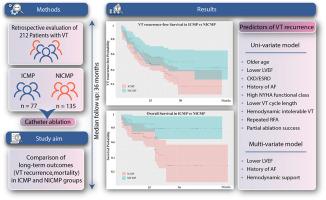缺血性和非缺血性心肌病患者室性心动过速消融的长期结果:来自单中心消融登记的数据
Q3 Medicine
引用次数: 0
摘要
目的:导管消融是治疗室性心动过速的有效方法。然而,对于非缺血性心肌病室间隔消融术后的长期预后,报道较少。我们的目的是比较缺血性心肌病(ICMP)和非缺血性心肌病(NICMP)患者VT消融的结果。方法:连续212例患者的急性手术和长期预后(ICMP, 135;NICMP, 77),因持续VT而消融,中位随访36个月的患者被收集和分析。结果:与NICMP患者相比,ICM患者年龄更大,男性更容易,LVEF更低,合并症更多,诱导性室性血栓数量更多。NICMP组患者的手术成功率更高(NICMP组为88.3%,而ICMP组为79.3%)。ICMP组的室速复发率为54.8%,NICMP组为38.9% (P值= 0.026)。ICMP组的总死亡率为22%,而NICMP组为7% (P值= 0.007)。此外,ICMP组的心脏死亡率明显高于NICMP组(19% vs. 6%) (P值= 0.011)。结论:VT消融在NICMP患者中是一种有效且安全的方法,使用目前可用的导管定位和消融技术,在可接受的低手术并发症的情况下,在相当数量的患者中获得了急性手术成功。总的来说,ICMP患者的手术失败明显比NICMP患者更频繁,并且与不健康的长期预后一致。本文章由计算机程序翻译,如有差异,请以英文原文为准。

Long-term outcomes of ventricular tachycardia ablation in ischemic and non-ischemic cardiomyopathy patients: Data from a single center ablation registry
Objective
Catheter ablation is effective in the treatment of ventricular tachycardia (VT). However, long-term outcomes after VT ablation in non-ischemic cardiomyopathy are sparsely described. We aimed to compare the outcomes of VT ablation between patients with ischemic cardiomyopathy (ICMP) and non-ischemic cardiomyopathy (NICMP).
Methods
Acute procedural and long-term outcomes of 212 consecutive patients (ICMP, 135; NICMP, 77) who were ablated for sustained VT and followed for a median of 36 months were gathered and analyzed.
Results
Compared with patients with NICMP, patients with ICM were older, more likely to be men, had lower LVEF, more comorbidities, and had a higher number of inducible VTs. Complete procedure success was higher in patients from the NICMP group (88.3 % in NICMP compared to 79.3 % in ICMP). VT recurrence occurred in 54.8 % of ICMP compared to 38.9 % of NICMP (P value = 0.026). The overall mortality rate was 22 % in the ICMP group, compared to 7 % in the NICMP group (P value = 0.007). Additionally, cardiac mortality occurred significantly more in the ICMP group than in the NICMP group (19 % vs. 6 %) (P value = 0.011).
Conclusion
VT ablation in patients with NICMP was found to be an effective and safe approach, achieving acute procedural success in a noticeable number of patients using the currently available catheter mapping and ablation techniques with acceptable low procedural complications. Overall, procedural failures were significantly more frequent in ICMP patients than in NICMP and were consistent with unhealthier long-term outcomes.
求助全文
通过发布文献求助,成功后即可免费获取论文全文。
去求助
来源期刊

Indian Pacing and Electrophysiology Journal
Medicine-Cardiology and Cardiovascular Medicine
CiteScore
2.20
自引率
0.00%
发文量
91
审稿时长
61 days
期刊介绍:
Indian Pacing and Electrophysiology Journal is a peer reviewed online journal devoted to cardiac pacing and electrophysiology. Editorial Advisory Board includes eminent personalities in the field of cardiac pacing and electrophysiology from Asia, Australia, Europe and North America.
 求助内容:
求助内容: 应助结果提醒方式:
应助结果提醒方式:


